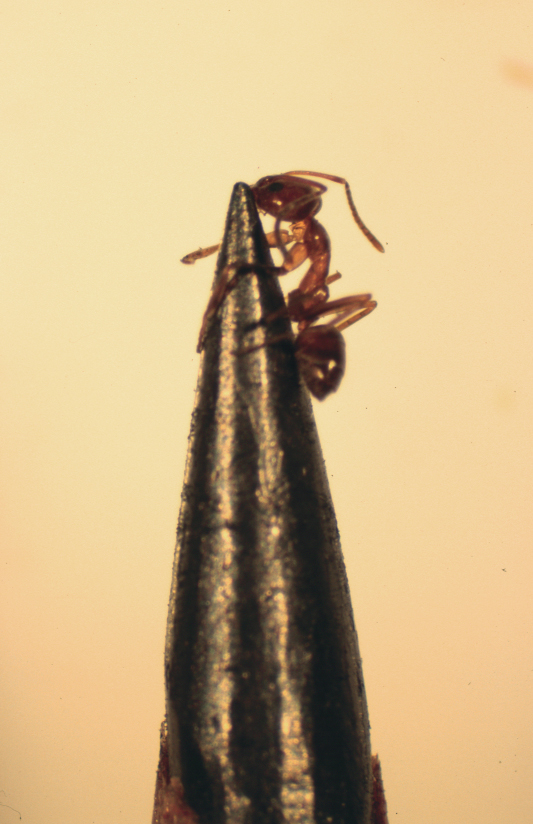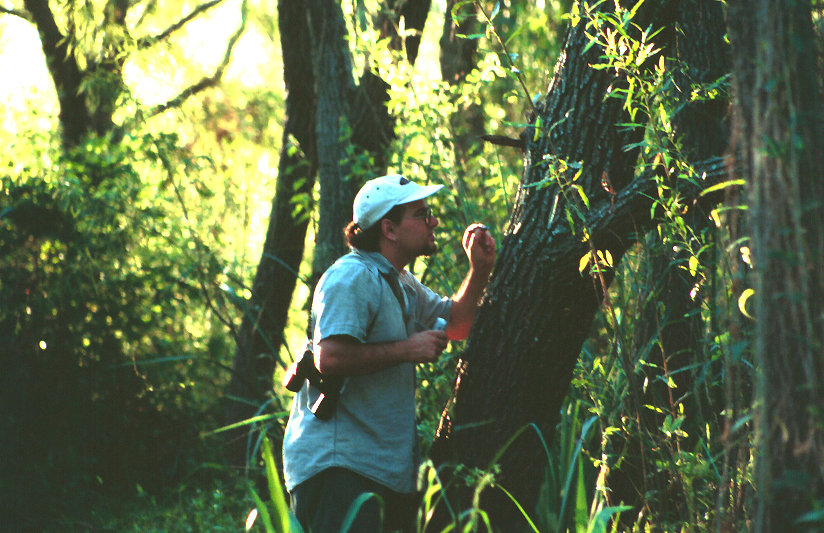Biologists Examine Success and Failures of Ant Invasions
November 15, 2005
By Kim McDonald
Many insects enter the United States accidentally as hitchhikers on various kinds of imported plants and other forms of human commerce. But how many of these potential pests actually become established once they arrive?
Conventional wisdom suggests the numbers could be estimated from the size of the insect invasions and the number of times they enter the United States. But new findings published in the journal Proceedings of the National Academy of Sciences by biologists at the University of Illinois and the University of California campuses at Davis and San Diego suggest that opportunity alone is no guarantee of a successful invasion.

Argentine ant on
pencil tip
pencil tip
Credit: Andrew
Suarez, UCSD
Suarez, UCSD
Of 232 species of ants that entered U.S. ports uninvited from 1927 to 1985, the scientists found that 28 species, or only 12 percent, now occur as established non-native species. Their report, which appears this week in an early online edition of the journal, is important because it provides ecologists with information on some of the factors that allow alien insect species to establish themselves.
"Our study is unique because it includes data on failed introductions for an important group of unintentionally introduced insects," said David A. Holway, an assistant professor of biology at the University of California, San Diego, who has been studying the introduction and spread of Argentine ants throughout California. "To identify the factors that affect establishment success, it is essential to understand why species do not become established when they are introduced into new environments. To date, few studies on introduced insects, other than those intentionally introduced for biological control, have addressed the issue of failed introductions."
One important factor in the ants' success is nesting preferences, the scientists discovered.

Andrew Suarez in Argentina
searching for Argentine ants
searching for Argentine ants
Credit: Neil Tsutsui, UCSD
"There are a huge number of species being moved around that don't become established, so opportunity alone isn't sufficient," said Andrew V. Suarez, an assistant professor in the entomology and animal biology departments at the University of Illinois at Urbana-Champaign and the first author of the paper. "This makes sense, because many of these species have specific biological characteristics that prevent them from becoming established in a new environment."
Ants that became established were either ground-nesting species or arboreal species that did not depend solely on specific types of trees common to their native lands, Suarez said.
"This kind of information is important," he added, "because it's going to help us to identify the characteristics that may promote the success of non-native organisms. Eventually, we can use this information to keep the new wave of invaders from becoming established."
Holway and Suarez, a former doctoral student at UCSD, have long been studying Argentine ants, an aggressive species that has caused problems throughout California by infesting homes and establishing large colonies that have displaced native species of ants and caused declines in lizards and other species that feed on native ants.
Suarez's work on the ants subsequently led him to the Smithsonian Institution's National Museum of Natural History, where he found a gold mine of untapped ant history. In numerous containers were mostly unidentified ants that the U.S. Department of Agriculture had captured at quarantine sites around the country. Each container was labeled with a port of departure and a port of entry. The ants had been collected from plants or plant material, mostly tropical in origin, before any of the ants had a chance to establish themselves.
Suarez, who was a postdoctoral student at UC Davis when he began the study, and Philip S. Ward, a professor of entomology at Davis and the third co-author of the paper, spent years identifying 232 different species from 58 genera and 12 subfamilies from the 394 records stored at the museum. Suarez and Ward then teamed with Holway at UCSD to analyze their discoveries.
Of the 232 species identified, the researchers were able to determine definitive data on nest-site preferences of 156 species. Using multiple-logistic regression, the scientists tested the influence of how many times in the records particular species were imported, nesting behavior and their interaction on the success or failure of successful establishment.
Slightly more than half of 156 species they identified were tree-nesting ants and only 14 percent of these arboreal ants (four species) became established in the U.S., probably because they weren't dependent on specific kinds of trees, Suarez said.
"As a group of introduced species, invasive ants are clearly important," Holway said. "Five species of ants, for example, are included in the top 100 worst invasive organisms by the IUCN (The World Conservation Union)."
The three researchers also noted the vital role that museums play in advancing scientific inquiry and they urged a new quarantine program to curate intercepted material. Their study was supported by the National Science Foundation.
